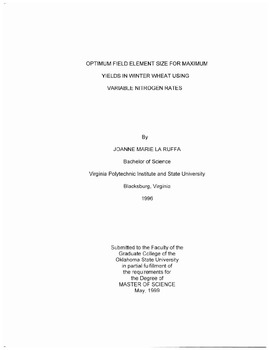| dc.contributor.author | La Ruffa, Joanne Marie | |
| dc.date.accessioned | 2014-09-29T15:04:20Z | |
| dc.date.available | 2014-09-29T15:04:20Z | |
| dc.date.issued | 1999-12-01 | |
| dc.identifier.uri | https://hdl.handle.net/11244/11780 | |
| dc.description.abstract | The resolution at which variability in soil test and yield parameters exists is fundamental to the efficient use of real-time sensor-based variable rate technology (s-VRT). This study was conducted to determine the optimum field element size that would account for the spatial variability of nitrogen in winter wheat (Triticum aestivum L.). The effect of nitrogen variability on yield was investigated at Tipton, Hennessey, and Perkins, Oklahoma. Results indicate that variability exists at resolutions less than or equal to one square meter. Increased yields at smaller harvested resolutions and reduced fertilizer costs are expected when using variable nitrogen rates based on NDVI values. Results from this study suggest that application of prescribed fertilizer rates based on differences at the 0.84 m2 resolution could lead to increased yields, decreased grower costs, and decreased environmental impact of excess fertilizers. | |
| dc.format | application/pdf | |
| dc.language | en_US | |
| dc.publisher | Oklahoma State University | |
| dc.rights | Copyright is held by the author who has granted the Oklahoma State University Library the non-exclusive right to share this material in its institutional repository. Contact Digital Library Services at lib-dls@okstate.edu or 405-744-9161 for the permission policy on the use, reproduction or distribution of this material. | |
| dc.title | Optimum Field Element Size for Maximum Yields in Winter Wheat Using Variable Nitrogen Rates | |
| dc.type | text | |
| osu.filename | Thesis-1999-L336o.pdf | |
| osu.accesstype | Open Access | |
| dc.type.genre | Thesis | |
